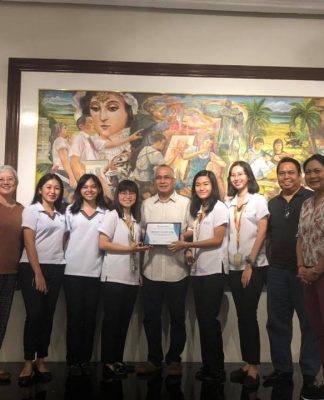FOOD ESTABLISHMENTS around the University claimed that the rice crisis threatens to kill their business, but experts say the crisis is artificial.
Owners of frequently visited canteens outside the campus plan to increase prices of rice servings. However, they said that the charges would still be affordable for students.
But economics professor Emmanuel Lopez, the head of the Department of Social Sciences of the Faculty of Arts and Letters, said the food shortage is caused by panic-buying and other factors that have nothing to do with food supply and sufficiency.
Almer’s Canteen owner Nene David and Fire Up the Grill Food House attendant Sonny Ubac said they would increase their rice servings by one peso.
Also, Teodora Bernardo, Lopez Canteen owner, said that their eatery will be increasing the costs of their meal servings.
“From P60, we will be charging P65 for every meal,” Bernardo told the Varsitarian. “We need the increase to sustain our business.”
Inside the University, Meals To Go manager Gerald Tayamen admitted that the car park-based eatery may be forced to stop serving double-rice meals if the Filipino staple becomes “inaccessible” due to limited supply and unabated price hike.
“If other restaurants are able to draw costumers even if they do not offer double rice in their meals, then, we could do the same,” Tayamen said. “But nothing is final yet. We will continue observing the markets before we decide.”
Meals To Go usually cooks 30 to 35 kilos of rice everyday before it dramatically reduced the volume to less than 10 kilos since news of the rice crisis broke out.
Miguel Agbulos, an incoming College of Science junior, does not personally feel the rice shortage but has noticed the reduced rice servings in some food chains around UST.
“This is why many of us (students) prefer to eat in Meals To Go because they automatically serve double-rice meals,” he said. “In other restaurants, their rice servings are not enough to satisfy us because they evidently reduced the rice and even increased their prices.”
Meanwhile, Ate Eva’s Grill sales clerk Teresa Vito said they will not lessen their rice servings.
“We anticipate the number of costumers per day so we could adjust how much rice we should cook,” Vito said. “This is how we prevent left-over food and conserve rice.”
Enough food for all
Economics professor Lopez said the so-called shortage is caused by unnecessary panic buying.
“Most people could no longer afford the high price of commercial rice today so they switch to the cheaper NFA rice. This shift makes it look as if shortage is occurring,” Lopez told the Varsitarian. “But in reality, there is no state of famine or shortage but plain panic-buying. Consumers are only avoiding the expensive commercial rice that is why there is a greater demand for NFA rice as an alternative.”
Moreover, Lopez said the increase in prices of oil and other necessities in the world market, without an equal increase in the people’s salaries, is also decreasing the value of peso, thus shrinking the food budget of most Filipinos.
Lopez added that natural phenomena like frequent storms and flooding also contributed to the price hike of almost all goods.
At the onset of the rice crisis, Agriculture Secretary Arthur Yap suggested that rice be mixed with corn to minimize rice consumption, which, according to Lopez will hardly sit well with the Filipinos’ appetite.
“This is like a flash-back of the 1970’s when people were encouraged to try a different diet due to a real shortage,” Lopez said. “Unfortunately, the new diet — mixing rice with corn— just pestered most Filipinos. Some of us experienced stomach problems back then.”
Lopez further stressed that the world’s natural resources, which could feed up to 30 billion people according to studies, is more than enough to arrest the hunger of the world’s eight billion population.
“Why panic when we are abundant with food? We, as part of the academe, must educate the people to prevent needless panic among them,” he added.
But for political science professor Dennis Coronacion, the rice crisis is just a money-making ploy by big-time rice producers and distributors.
“This rice shortage is artificial. The (rice) cartel, composed of the few and richest businessmen, would only like to justify the government’s importation of rice and be able to give reasons why they should increase the price,” Coronacion said.
Coronacion also believed that some government officials are benefiting from “this dramatically crafted crisis scenario” in connivance with an alleged rice cartel of middlemen and businessmen.
But Lopez said there’s nothing “political” about the rice issue.
“I do not see any propaganda,” Lopez said. “The rice shortage is just in the minds of the people.” With reports from Emil Karlo A. dela Cruz















